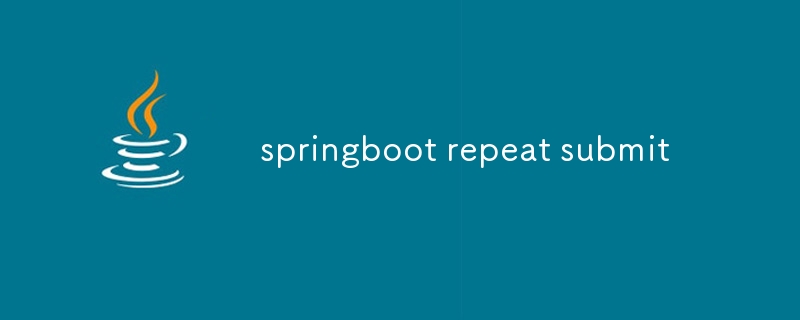Heim >Java >javaLernprogramm >Springboot wiederholen
Springboot wiederholen
- DDDOriginal
- 2024-08-15 15:18:18411Durchsuche
This article discusses various approaches for preventing repeat form submissions in Springboot applications. It explores adding CSRF tokens, using the @ValidateOnSubmit annotation, generating unique request identifiers, implementing rate limiters, an

Springboot Repeat Submit
1. How to Prevent Repeat Submissions with Springboot?
Springboot provides several approaches to prevent repeat submissions:
- Adding a CSRF Token: Cross-Site Request Forgery (CSRF) tokens are unique per session and prevent unauthorized submissions.
- Using the @ValidateOnSubmit Annotation: This checks for duplicate requests based on a form's input parameters.
- Generating Unique Request Identifiers: A GUID or timestamp can be used to prevent resubmitting the same request.
- Implementing a Rate Limiter: Limiting the rate of requests can discourage malicious attempts to repeat submissions.
2. Best Practices for Handling Repeat Submissions in Springboot Applications
- Implement multiple prevention mechanisms to enhance security.
- Use CSRF tokens as the primary defense against cross-site attacks.
- Configure appropriate rate limits to prevent excessive requests.
- Log and track all submission attempts for auditing purposes.
- Consider using a third-party library specifically designed for handling repeat submissions.
3. Is There a Springboot Annotation or Feature to Automatically Handle Repeat Submissions?
Yes, Spring Security provides the @RepeatedSubmit annotation that helps prevent double form submissions by verifying that a unique token is included in the request.
Here's an example:
<code class="java">@PostMapping("/")
@RepeatedSubmit(value = true)
public String handleSubmit() {
// Handle the form submission
return "success";
}</code>Das obige ist der detaillierte Inhalt vonSpringboot wiederholen. Für weitere Informationen folgen Sie bitte anderen verwandten Artikeln auf der PHP chinesischen Website!
In Verbindung stehende Artikel
Mehr sehen- Beispiel für die Verwendung einer Lese-/Schreibsperre für die Java-Multithread-Programmierung ReadWriteLock
- Java implementiert eine einfache Baumstruktur
- Java implementiert einfachen Stack-Code
- Java-Beispiel – Verwendung von Schlüsselwörtern fortsetzen
- Java Virtual Machine Learning – Architektur-Speichermodell

